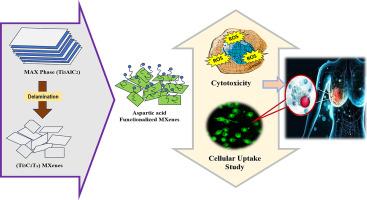Synthesis and functionalization of 2D Ti3C2Tx layered MXenes: assessment of toxicological interventions in triple negative breast cancer
IF 5.4
3区 化学
Q1 CHEMISTRY, INORGANIC & NUCLEAR
引用次数: 0
Abstract
Cancer remains a serious and life-threatening disease despite advancements in therapy and drug delivery systems. In this context, nanomaterials have emerged as a promising alternative for targeted cancer therapies. Among these, Ti₃C₂Tₓ (MXenes), a class of two-dimensional (2D) nanomaterials, exhibit unique properties such as high surface area, excellent hydrophilicity, and versatile surface chemistry, making them highly promising for biomedical applications. This study presents a modified synthesis method for MXenes using potassium fluoride (KF) and hydrochloric acid (HCl), thereby eliminating hazardous hydrofluoric acid (HF) and improving safety and sustainability. The resulting MXenes were further functionalized with aspartic acid (Asp-MXenes) via hydrothermal treatment to enhance their surface functionality and biological interaction. Instrumental assessments confirmed successful functionalization, reflected by changes in particle size, surface charge and optical properties. In-vitro studies showed that significantly enhanced cytotoxicity of Asp-MXenes against MDA-MB-231 breast cancer cells compared to unmodified MXene. Confocal microscopy revealed improved cellular uptake of Asp-MXenes, correlating with their improved cytotoxicity.
Apoptosis analysis indicated a greater apoptotic population following treatment with Asp-MXenes, while Reactive oxygen species (ROS) analysis showed elevated ROS levels in treated cells, supporting a ROS-mediated mechanism of apoptosis. These preliminary findings suggest that Asp-MXenes may exhibit enhanced cellular uptake and induce ROS-mediated apoptosis in cancer cells, indicating their promise as potential anticancer agents. This study underscores the role of surface functionalization in improving MXenes bioactivity and supports eco-friendly synthesis for biomedical applications. In summary, the study serves as a fundamental aspects of the theranostic development in biomedical applications.

二维Ti3C2Tx层状MXenes的合成和功能化:三阴性乳腺癌毒理学干预评估
尽管治疗和药物输送系统取得了进步,但癌症仍然是一种严重且危及生命的疾病。在这种情况下,纳米材料已经成为靶向癌症治疗的一个有希望的替代方案。其中,Ti₃C₂Tₓ(MXenes)是一类二维(2D)纳米材料,具有高表面积、优异的亲水性和多用途的表面化学等独特性质,在生物医学应用方面具有很大的前景。本研究提出了一种利用氟化钾(KF)和盐酸(HCl)合成MXenes的改进方法,从而消除了有害的氢氟酸(HF),提高了安全性和可持续性。得到的MXenes通过水热处理进一步与天冬氨酸(Asp-MXenes)功能化,以增强其表面功能和生物相互作用。仪器评估证实了成功的功能化,反映在粒径、表面电荷和光学性质的变化上。体外研究表明,与未修饰的MXene相比,asp -MXene对MDA-MB-231乳腺癌细胞的细胞毒性显著增强。共聚焦显微镜显示Asp-MXenes的细胞摄取改善,与细胞毒性改善相关。凋亡分析表明,Asp-MXenes处理后,凋亡群体增加,而活性氧(ROS)分析显示,处理细胞中ROS水平升高,支持ROS介导的凋亡机制。这些初步研究结果表明,Asp-MXenes可能在癌细胞中表现出增强的细胞摄取并诱导ros介导的细胞凋亡,这表明它们有望成为潜在的抗癌药物。该研究强调了表面功能化在提高MXenes生物活性中的作用,并为生物医学应用的生态合成提供了支持。总之,该研究是生物医学应用中治疗学发展的一个基础方面。
本文章由计算机程序翻译,如有差异,请以英文原文为准。
求助全文
约1分钟内获得全文
求助全文
来源期刊

Inorganic Chemistry Communications
化学-无机化学与核化学
CiteScore
5.50
自引率
7.90%
发文量
1013
审稿时长
53 days
期刊介绍:
Launched in January 1998, Inorganic Chemistry Communications is an international journal dedicated to the rapid publication of short communications in the major areas of inorganic, organometallic and supramolecular chemistry. Topics include synthetic and reaction chemistry, kinetics and mechanisms of reactions, bioinorganic chemistry, photochemistry and the use of metal and organometallic compounds in stoichiometric and catalytic synthesis or organic compounds.
 求助内容:
求助内容: 应助结果提醒方式:
应助结果提醒方式:


